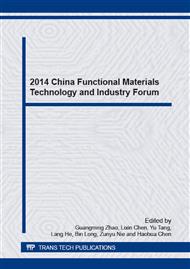p.412
p.419
p.426
p.433
p.438
p.443
p.451
p.459
p.464
Effects of Ni/Co Metal Binder Phase on Mechanical Properties of Ti(C,N)-Based Cermets
Abstract:
Ti(C,N)-based cermets were prepared by pressureless sintering using micron-sized TiC and TiN powders as main starting materials and Ni and Co as metal binders. The fracture micrographs of Ti(C,N)-based cermets were observed by SEM. The effects of metal binder phase content on porosity and mechanical properties of Ti(C,N)-based cermets were investigated. The results show that when sintering at 1450 °C for 50min, typical core/rim microstructure is observed in the cermets, which is compact and distributed homogeneously, the density and relative density are 5.9 g/cm3 and 95.6%, respectively. Intergranular fracture is the main crack propagation mode, with a few of the transgranular fracture, and there are more dimples and tearing ridges in the fracture surface. Using the same sintering process, Ti(C,N)-based cermets with metal binder content of 10%Ni5%Co has a compact microstructure and fine grains, the metal binder phase is dispersed more evenly, the best vicker hardness, bending strength and fracture toughness of Ti(C,N)-based cermets are 15.8 GPa, 885.5MPa and 9.7 MPa·m1/2, respectively. However, Ti(C,N)-based cermets with Ni replaced of high Co content will generate some brittle intermetallic compound, its toughness is inferior to the metal binder phase, which reduces the strength and toughness of Ti(C,N)-based cermet materials.
Info:
Periodical:
Pages:
438-442
Citation:
Online since:
December 2014
Authors:
Price:
Сopyright:
© 2015 Trans Tech Publications Ltd. All Rights Reserved
Share:
Citation:


